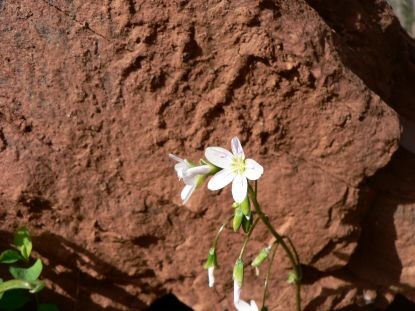
NPS Photo The two major geologic units of the battlefield – siltstone and diabase – greatly influence soil development, texture, and chemistry.
ReferencesFleming, G.P. and J.T. Weber. 2003. Inventory, classification, and map of forested ecological communities at Manassas National Battlefield Park, Virginia. Natural Heritage Tech. Rep. 03-7. Virginia Department of Conservation and Recreation, Division of Natural Heritage, Richmond. Unpublished report submitted to the National Park Service. 101 pp. plus appendix. Elder, J.H. 1989. Soil survey of Prince William County, Virginia. U.S.D.A. Soil Conservation Service in cooperation with Virginia Polytechnic Institute and State University. U.S. Government Printing Office, Washington, D.C. 245 pp. plus maps. Los suelos
Las dos principales unidades geológicas del campo de batalla (Silestone y diabasa) influyen grandemente química, textura y desarrollo del suelo. En general, resistidos de diabasa suelos son arcillosos, ricos en minerales de la arcilla y Tilting un bien han desarrollado barreno subsuelo limitan la permeabilidad. Además, tienen significativamente mayor pH, calcio, magnesio y manganeso concentraciones, junto con concentraciones significativamente más bajas de hierro, soportó los suelos de Silestone.Aunque algunos de estos últimos tienen subsuelos arcilla moderada, la mayoría tienen horizontes superiores limosas y subsuelos arcillosos con buen drenaje. Soportó la mayoría de suelos residuales de las tierras altas de Silestone son fuertemente o extremadamente ácida, con concentraciones relativamente bajas (excepto el hierro). Sin embargo, por debajo del límite de la lixiviación de superficie, material calcáreo del suelo puede ser abundante y se expone con frecuencia en las laderas escarpadas y bluffs socavado por las corrientes. El estudio de suelos para Prince William County (Elder 1989) indica que aproximadamente el 79% de los suelos en el parque se derivan de Silestone o metasiltstone, con el resto resistido de diabasa (19%) o de aluvión (2%). Los tipos más comunes de suelo, cubriendo más del 40% del parque, pertenecen a la serie Arcola y Nestoria. Estos suelos son moderadamente profundos con sedimentos superficiales, bien drenados con franco limoso de grava subsuelos. |
Last updated: November 22, 2022
